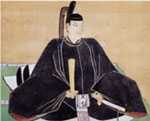Niwa Nagaaki
| Niwa Nagaaki | |
|---|---|
 | |
| Lord of Nihonmatsu | |
| In office 1796–1813 | |
| Preceded by | Niwa Nagataka |
| Succeeded by | Niwa Nagatomi |
| Personal details | |
| Born | November 18, 1780 |
| Died | September 19, 1813 (aged 32), aged 32 |
| Nationality | Japanese |
Niwa Nagaaki (丹羽長祥) (November 18, 1780 – September 19, 1813) was a Japanese daimyo of the late Edo period who ruled Nihonmatsu han.
Biography
Nagaaki, first known by his childhood name of Nabetarō (鍋太郎), was the eldest son of Niwa Nagataka, the preceding daimyo of Nihonmatsu. On June 17, 1796, he succeeded to family headship, following the death of his father. His fundamental approach from the time of his succession onwards was that of fixing the domain's finances. Relying on his reformist Karō Narita Yoriyasu (成田頼綏), he encouraged agriculture, promoted education, and assisted in the development of special crafts amongst the commoners. It was at this point that Nihonmatsu's famed Banko-yaki (二本松万古焼) glazed pottery, Kawasaki paper (川崎の紙), Hiraishi tatami (平石の畳), and Ōhira kushikaki (大平串柿; skewered persimmons) were first originated.[1] Nagaaki also encouraged sericulture and established horse and silk markets in Nihonmatsu.[1]
Despite these reforms, the domain's finances were hard pressed due to natural disasters and other unforeseen events, as well as the shogunate's request for monetary and construction assistance on a flood control project.[1]
Nagaaki held the title of Sakyō-dayū (左京大夫), and the junior 4th court rank, lower grade (jū shi-i no ge 従四位下).[1]
Nagaaki died in 1813, and was succeeded by his eldest son Nagatomi.
Notes
| Preceded by Niwa Nagataka |
Daimyō of Nihonmatsu 1796-1813 |
Succeeded by Niwa Nagatomi |
Further reading
- Nihonmatsu-han shi 二本松藩史. Tokyo: Nihonmatsu-hanshi kankōkai 二本松藩史刊行会, 1926 (republished by Rekishi Toshosha 歴史図書社, 1973)
- Sugeno Shigeru 菅野与. Ōshū Nihonmatsu-han nenpyō 奥州二本松藩年表. Aizu-Wakamatsu shi 会津若松市: Rekishi Shunjūsha 歴史春秋社, 2004.
External links
- Biography of Nagaaki (in Japanese)